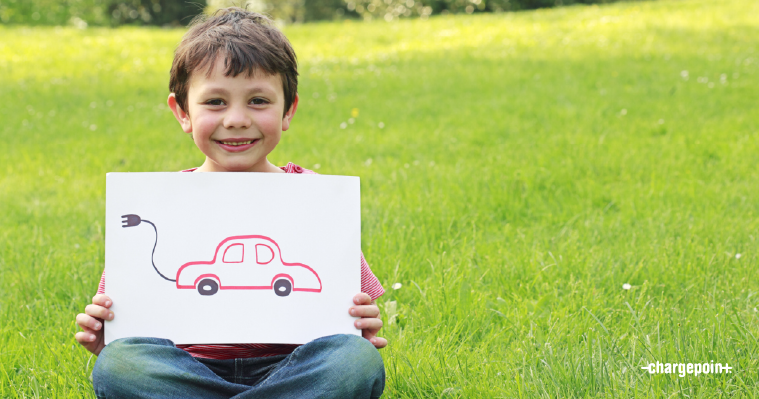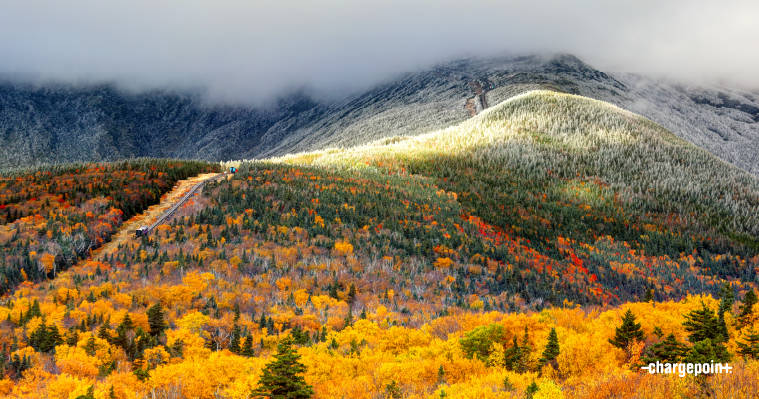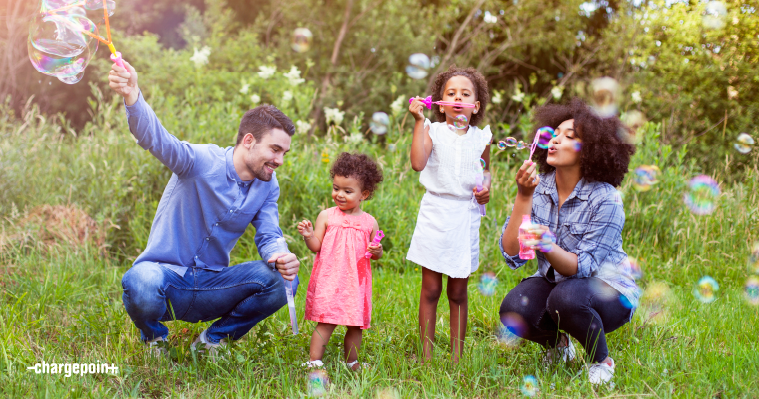
Forest fires, hurricanes, drought, tornados, atmospheric rivers and bomb cyclones — weather extremes have become common news items that leave many of us feeling unsettled. The events themselves upend lives, and the reality of what climate change means for our planet over the next few decades can be overwhelming. For kids, the situation is not only confusing but sometimes anxiety-producing.
A 2021 survey of 10,000 young people ages 16-25 in 10 countries, published in The Lancet, found that 84% were at least moderately worried about climate change, and 68% reported feeling sad and anxious about it.
As adults, it’s our job to educate and support the kids in our lives around climate issues and instill a sense of hope for the future. For this Earth Day, ChargePoint parents share how they approach the subject of climate change with their children. Here are the top six suggestions.
1. Be open
A 2019 NPR poll found that 85% of parents thought it was important to talk with kids about climate change but only 45% actually had talked with their own kids.
Part of the difficulty is that we aren’t comfortable with the topic. Educate yourself on climate science so that you have the facts. Talk with friends to overcome your own anxiety around climate change and know that you are not alone.
Many kids know someone who has experienced a flood, tornado or forest fire, which makes the topic difficult to avoid. Be open and willing to have conversations as these topics come up. Know that it’s okay if you can’t answer all the questions — you can do research and learn together.
“My daughter usually starts the conversation, based on whatever we are seeing or hearing at that moment,” said Makeda Mengistu, senior web developer and mother of two children, ages 8 and 4. “When she was younger, we talked about helping the earth and would go to clean up the beach on Earth Day. When we got our first EV, we had a conversation about how that can help the earth.”
2. Get outside
Nurture a love of exploring and protecting nature. If kids grow up respecting nature, they will be more likely to work to protect it throughout their lives. Spend time outside. Look at bugs. Learn to identify trees, flowers and birds. Check out the sky. Get your hands dirty in the garden. Hands-on experience with nature will help kids better understand the issues as they get older.
Teach kids that everything in nature is interconnected. Show them how the trees in your own backyard or the local park are doing their part by removing carbon emissions from the air, storing it in their leaves, branches, trunks and roots, and releasing oxygen back into the atmosphere.
“I think helping kids feel connected to nature is one of the most important pieces of teaching climate awareness because so many of us living in cities and suburbs can feel completely disconnected from it as if it doesn’t even matter to us, but it does,” said Marissa Galizia, director of Portfolio Management and mother of one son, age 2.5.

3. Give kids the basics
Early education is key to developing climate awareness and normalizing simple actions we can all take in our day-to-day lives to protect the environment. Keep information simple, direct and age appropriate. Start conversations by asking children to share what they know and then relate the conversation back to their daily lives.
Olivia Brewer teaches sixth-grade English and Language Arts in Wake County Public Schools in Raleigh, North Carolina, and uses young adult novels that address climate change and the wide-scale effect it has on our world.
“Since our curriculum introduces the concepts, I attempt to connect it back to students’ own experiences and how their actions have consequences,” Brewer said. Leaving the lights on, for example, not only raises our electricity bill, but it also uses more power than necessary, which requires more fuel to be burned, which releases more carbon into the atmosphere. Knowing these consequences can help children understand the “why” behind their choices.
According to Brewer, students who are in sixth grade have a fundamentally different understanding of the world around them even compared with eighth graders. “At the sixth-grade level, we try to emphasize why they should care by relating it to their lives. An older student can begin to understand the global impacts of climate change and view it as a call to action.”
4. Address feelings
Make sure kids know that you are a safe, open, caring adult who they can talk to and share their concerns without fear of judgement. If your children are worried about the future of the planet, focus on feelings first — before trying to solve the problems they are concerned about. Listen and give them space to share.
“The more we can chunk things up in changing our habits, the less heavy or overwhelming it feels,” said Christine Vaeth, director of Growth Marketing and mother of one son, age 9. “I am very honest with my son about where we choose to make changes, and where it may not make sense to change. It’s a balance, and every person or family must figure out what is right for them.”
Encourage kids to do positive or comforting activities with people they love. Spend time in nature and take a break from the news. With older kids, learning more about climate issues and finding concrete ways to make a difference can help reduce anxiety.
“Our kids are still young and filled with hope and curiosity,” said Matt Schaeffer, product marketing manager and father of three children, ages 7, 5 and 2. "But we will teach them that anxiety and stress can be managed, in part, by action — and that action needs to come from their own creativity, and we will support it.”
5. Take action
Help kids feel empowered to respond directly to the issue of climate change. Learning to make climate-friendly choices as well as getting involved to support environmental causes are both important ways to take action.
Lead by example in developing habits such as picking up litter, recycling, using less water, turning off lights, eating less meat and driving electric. Even toddlers can begin to develop an awareness of how to take care of our planet.
Volunteer as a family with local environmental groups and attend community events. But follow your children’s interests and allow them to choose what to get involved with.
“We recycle, drive electric, donate to charities, reduce electricity usage, move usage to times when our solar panels generate more electricity and talk to others about the climate,” said Kevin Doyle, senior director of Product Management and father of teens, ages 15 and 12. “My kids are also quite vocal in school, and they often educate their peers (and even teachers) about the electric vehicle industry and other climate topics.”

6. Find hope
Talking to one another, getting out into nature, learning as much as possible and working together to make good choices and get involved all generate a sense of hope.
Encourage kids to look around to see what climate actions are taking place in their own communities. Many cities are adopting electric buses. Groups of volunteers are planting trees along roadways. Composting is becoming the norm in many municipalities. Point out these hopeful signs to your children.
Find examples of other children and teens around the world who are making a difference. Seeing that others are also concerned about climate change will show our children that they are not alone. We are all in this together.
Leading the charge on Earth Day
Earth Day is pretty much every day at ChargePoint because we spend our time laser-focused on supporting the transition to electric mobility, with the ultimate goal of reducing greenhouse gas (GHG) emissions and fostering a healthier planet. Since our founding in 2007, we’ve charged 158 million vehicles and helped our customers avoid 200 million gallons of gasoline. The GHG emissions savings from all those charges are equivalent to planting over 21 million tree seedlings and letting them grow for 10 years. That’s pretty inspiring!
Want to learn more about driving electric? Drive Electric Earth Day is a national campaign designed to share information about electric vehicles throughout the month of April. Click below to learn more and find an online or in-person Drive Electric event near you.
